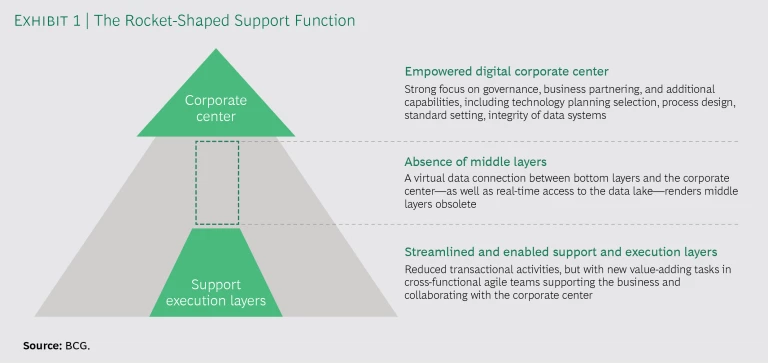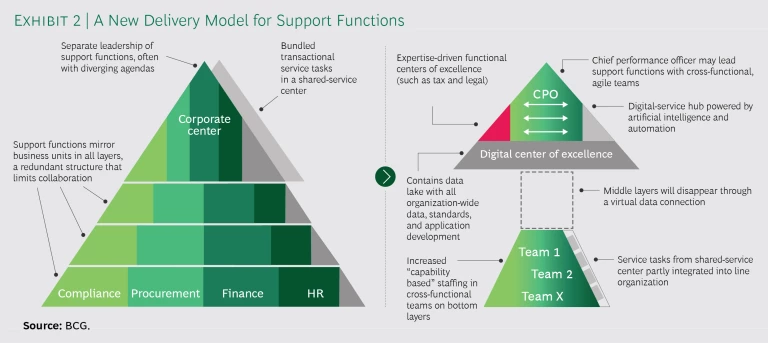At most organizations, support functions still look largely the same today as they did two or three decades ago. They feature a traditional, pyramid-shaped organizational structure in which functions like HR, legal, and finance are set up to mirror the business units. We believe this is an outdated approach and one that will become even less tenable over time. Digital technology is changing just about every aspect of how companies operate—and companies will not be able to capitalize on digital unless they put the right operating model in place. Otherwise, they’re essentially trying to bolt a turbocharged engine onto a wooden cart.
Support functions can only capitalize on digital if they are reorganized to better reflect the way that technology changes how work gets done. For this reason, the support function of the future will be rocket-shaped, rather than pyramid-shaped. (See Exhibit 1.) At the top will be a stronger digital corporate center, controlling data, setting governance policies, and providing insights to help steer the business.
This structure will have fewer middle layers—and potentially none—because there will no longer be a need for multiple levels of reporting and management. At the bottom, automated tools embedded within business units will take over many transactional tasks, executing them faster and more accurately, and at lower cost (customized for the needs of local markets).
This new structure won’t match that of the overall organization—in terms of business units and geographic markets—and it doesn’t need to.
The Traditional Model for Support Functions
There are several reasons why support functions have evolved to look the way they do. First, they were set up so that each function has a matching corollary within each business unit and region. Therefore, steering functions are essentially a miniature reflection of the overall organization. In addition, the way work used to get done in support functions—largely manually—required the pyramid structure. A small number of leaders at the top made strategic decisions, midlevel managers primarily reported information up the chain of command and gave orders back down the chain, and armies of employees at the lower levels executed manual, mundane tasks.
Support functions can only capitalize on digital if they are reorganized to better reflect the way that technology changes how work gets done.
For resource-heavy manual activities, the basic design principle was to bundle and standardize them and optimize for factor costs, which resulted in a shared-service center (often offshore) sitting next to the pyramid structure in the org chart.
Finally, information flows were a factor in traditional org designs as well. In the past, business units alone had direct access to frontline information, which had to be aggregated, consolidated, and reported up to the corporate center so that leaders could make sense of it and decide on the right strategic direction. In the analog world, that approach was the only real option, but it led to significant complexity and redundancy.
New Technologies Require a New Operating Model
New technologies allow support functions to work in new ways and to streamline their overall operating model. Specific enabling technologies include the following:
- Big Data. New tools allow companies to collect, validate, store, and process large amounts of information—at far lower cost and at higher quality levels than in the past—and make it more accessible to leaders. For example, data lakes can work with the existing unstructured data that many organizations already have (often in tremendous volume) but do not yet capitalize on. As a result, support functions can proactively identify business needs—and even develop solutions—through increased transparency and smarter business insights.
- Global Connectivity. Cloud computing, software-as-a-service, and mobile/wearable devices make data-driven insights more accessible throughout the organization, in real time. This increased connectivity allows support function employees to collaborate in new ways and make smarter and faster decisions.
- Artificial Intelligence and Machine Learning. Advanced technologies allow companies to automate repetitive transactional tasks and rule-based activities through robotic process automation. And with machine learning, technology can increasingly handle processes that require some judgment as well. Algorithms can work 24/7 with greater accuracy and at lower cost. Even self-service functions become smarter through AI.
In the aggregate, these three technologies will completely disrupt the established model of support functions. Given the number of people working in support functions and their total cost worldwide, digitization represents a $1 trillion dollar opportunity. (See “ The $1 Trillion Opportunity in Digital Support Functions ,” BCG article, August 2018.)
Launching the Rocket-Shaped Support Function
As companies implement these technologies, they will need to rethink the support function operating model. Digitization not only affects how some tasks and processes are executed—it renders other processes entirely obsolete. Companies will require an operating model that is faster and more responsive—one that exploits the advantages of digital technology in a way that dramatically boosts performance.
The rocket-shaped design for support functions meets these requirements, differing from the traditional pyramid-shaped design in several critical ways. (See Exhibit 2.)
First, steering functions—those focused on creating strategic value through partnerships with business units such as HR and financial planning and analysis—will be consolidated in a corporate center. Increased data transparency means that these steering functions will be able to access extremely granular information across the entire enterprise—without sacrificing any visibility into performance—and use it to generate insights that help steer the business. The corporate center will also establish governance standards for the entire organization, provide data analysis services, develop tools, manage vendor relations, and implement new technologies as they become available.
Second, the boundaries between traditional functions will become more blurry. Agile, cross-functional teams will come together to handle specific tasks on a project basis. In extreme cases, forward-thinking companies may even consolidate functions such as finance, HR, legal, and IT, placing them under the leadership of a single individual—the chief performance officer.
Third, as tasks become increasingly automated, transactional activities—which sit in a shared-service center at most companies today—will be replaced by automated platforms and tools that can be directly accessed by the businesses. Companies will still need functional partners who have expertise in key areas, such as HR or finance, to support strategic decisions. And initially, small teams may be needed to customize processes and functions to meet local needs. These teams will serve local businesses and geographic markets and act as navigators, connecting insights from data with functional- and/or business-specific knowledge. But thanks to automation, they will require far fewer employees, and over time that number will continue to drop, as additional tasks become automated and moved to the digital-service hub.
The middle layers of support functions will decline dramatically--and in some cases, completely disappear.
Notably, the middle layers of support functions will decline dramatically—and in some cases, completely disappear. Those layers will be replaced by a virtual data connection between the transactional and automated bottom units and the corporate center on top—with processes in place to automatically report data up to the corporate center from the executing bottom layers. Data will flow across the organization through automated tools and platforms, giving leaders access to extremely granular information at the level of individual sites and even machines. In addition, outsourcing and offshoring of shared services will no longer be a major means of reducing costs; in fact, highly automatable tasks will be handled entirely through internal digital tools.
Clear Advantages
Compared to the traditional approach, the rocket-shaped structure encourages far greater speed and agility. Companies will be able to reduce costs and use data to create value in new ways. Support functions will be much leaner and become true partners to the business, since they will be free to focus on strategic elements rather than day-to-day transactions. Decision making will happen much faster—thanks to increased transparency into performance—leading to increased agility. The traditional tradeoffs between speed, quality, and costs will disappear. Companies will get faster and more accurate information—with far greater detail—at lower cost. And organizations will be able to customize their support services to the needs of local business units and markets, which is a drastic shift from the current move to standardization.
Compared to the traditional approach, the rocket-shaped structure encourages far greater speed and agility.
Consider the following potential applications:
- In HR, new-employee onboarding times can drop from six months to two weeks, thanks to AI-assisted models that provide instant, on-demand support and self-serve access to learning modules.
- In procurement, managers can access a data-rich web portal that helps them choose the right product, assess suppliers, and get purchases approved at lower cost (thanks to bundled sales across the entire organization, leading to volume discounts) and with fewer mistaken orders. Completed orders can happen in as little as seven minutes, down from three hours in the past. Managers can also track inbound shipments via the portal.
- In finance, budget forecasting processes can use a central system that dynamically consolidates and analyzes plans from individual units. Rather than the three months that such forecasts used to take, companies can complete the process in about one week. (See “How the Rocket-Shaped Support Function Is Transforming Financial Planning and Analysis.”)
How the rocket-shaped support function is transforming financial planning and analysis
How the rocket-shaped support function is transforming financial planning and analysis
In most companies, the financial planning and analysis function aggregates and interprets all performance information. In many cases, this is a cumbersome process. Yet some organizations are already implementing the new support structure and using digital tools to rethink and improve key processes in the following ways:
- Steering functions are moving from a pyramid structure to a rocket structure. One division of a large industrial company is using the group-wide single source of truth to create a new planning model. The model allows users to update assumptions via an easy web interface and see how they affect the budget. This eliminates the need for full-scale, bottom-up budgeting, which traditionally has had to be aggregated across many levels of the organization.
Similarly, a financial services company has automated its forecast process by using AI-based algorithms. It uses historical company data and external market information to predict how key performance indicators will likely react. The company still uses some traditional inputs to capture aspects that the algorithm can’t, such as outlier events. - The boundaries between functions are blurring. A health care company is employing agile principles to dynamically assemble cross-functional “insight teams” to answer critical business questions. These teams consist of subject matter experts from finance, HR, and other support functions as well as from the individual businesses.
In another example, an industrial conglomerate set up a cross-functional performance management organization. The unit includes subject matter experts from finance, other support functions, and business operations to evaluate opportunities holistically. Cross-functional subteams handle the implementation of any subsequent measures. - Unlike steering functions, service functions are getting reintegrated into business units. A financial services company has moved from paper-based reporting to a comprehensive set of dashboards. For performance meetings, the team can pull data far more quickly and assemble it into a “storyboard.” The data is dynamically updated and participants can drill down into specific metrics when the discussion warrants.
Equally noteworthy, an automotive OEM is automating its transactional processes in several locations. Staffers in each location work from a common platform, meaning they can all access and process transactions. This reduces the need for physical bundling and offshoring of these activities.
- In compliance, employee expense reports can be reviewed and vetted electronically, using robotic process automation tools and machine learning algorithms, leading to an 80% reduction in the workload for compliance employees.
How to Get Started
In order to prepare the organization to digitally transform support functions, leaders should focus on the following priorities:
- Create a solid baseline by understanding current service levels, customer satisfaction, capabilities, and resource allocation across support functions.
- Start building critical digital enablers, particularly data lakes (which can handle large volumes of unstructured data) and analytical skills for the overall organization, along with mechanisms to capture real-time data across business units. (See “ What to Do When Support Functions Aren’t Ready for Digital ,” BCG article, July 2018.)
- Identify and begin to implement individual use cases—such as advanced analytics to support decision making within the corporate center—and establish a test-and-learn cycle across these lighthouse projects.
- Define and address key architecture questions. For example, organizations can build around next-level, off-the-shelf integrated ERP systems (such as SAP HANA) or build central steering capabilities and tools over the top of their existing IT platforms.
- For specific processes within service functions, start by assessing their potential for automation, either through robotics or redesign of end-to-end workflows.
- Based on initial lessons, develop high-level targets and create a multiyear transformation roadmap.
The digital future of support functions will be exciting. As traditional, time-intensive tasks like forecasting, reporting, and distributing information come to be handled through smart digital tools, people can focus on asking the right questions, running and interpreting analyses, drawing conclusions, managing tradeoffs, and generating insights that help business units create new value. Capitalizing on this potential requires that companies start putting the right organizational structure in place.












